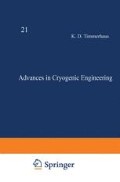Abstract
Alternative fuels for motor vehicles are needed to help satisfy the nation’s enormous appetite for transportation fuels. Cryogenic liquids—liquefied natural gas and liquid hydrogen—are candidate fuels. Liquefied natural gas (LNG) is attractive for the near term, while hydrogen is projected to be “the fuel of the future.” Both cryogens offer important advantages over other fuels now in use or being considered. Both are low-polluting and have a high energy content per unit weight. Some data on pollution levels and combustion engine performance for these fuels have already been reported in the literature [1–6].
Access this chapter
Tax calculation will be finalised at checkout
Purchases are for personal use only
Preview
Unable to display preview. Download preview PDF.
References
Environmental Protection Agency, Office of Air Programs, “Conversion of Motor Vehicles to Gaseous Fuel to Reduce Air Pollution” (April 1972).
California Air Resources Board, “Project M175—Emission Test of San Diego LNG Fuel System,” Air Resources Laboratory, Los Angeles, California (February 1969).
General Services Administration, “A Report on the GSA’s Dual-Fuel Vehicle Experiment—Pollution Reduction with Cost Savings,” U. S. Government Printing Office, Stock No. 2205–0002 (1971).
R. W. McJones and R. J. Corbeil, “Natural Gas Fueled Vehicles Exhaust Emissions and Operational Characteristics,” SAE paper 700078 (1970).
R. G. Murray and R. J. Schoeppel, “Emission and Performance Characteristics of an Air-Breathing Hydrogen-Fueled Internal Combustion Engine,” SAE paper 719009 (1971).
J. G. Finegold, F. E. Lynch, N. R. Baker, R. Takahashi, and A. F. Bush, “The UCLA Hydrogen Car: Design, Construction and Performance,” SAE paper 730507 (1973).
U. S. Patent No. 3,487,971 (January 6, 1970).
U.S. Patent No. 3,905,508 (September 16, 1975).
J. T. Foley, “The Environment Experienced by Cargo on a Flatbed Tractor-Trailer Combination,” Sandia Corporation, Research Rept. SC-RR-677 (December 1966).
Author information
Authors and Affiliations
Editor information
Editors and Affiliations
Rights and permissions
Copyright information
© 1960 Springer Science+Business Media New York
About this chapter
Cite this chapter
Hibl, J.J. (1960). Cryogenic Fuel Systems for Motor Vehicles. In: Timmerhaus, K.D., Weitzel, D.H. (eds) Advances in Cryogenic Engineering. Advances in Cryogenic Engineering, vol 21. Springer, Boston, MA. https://doi.org/10.1007/978-1-4757-0208-8_20
Download citation
DOI: https://doi.org/10.1007/978-1-4757-0208-8_20
Publisher Name: Springer, Boston, MA
Print ISBN: 978-1-4757-0210-1
Online ISBN: 978-1-4757-0208-8
eBook Packages: Springer Book Archive

